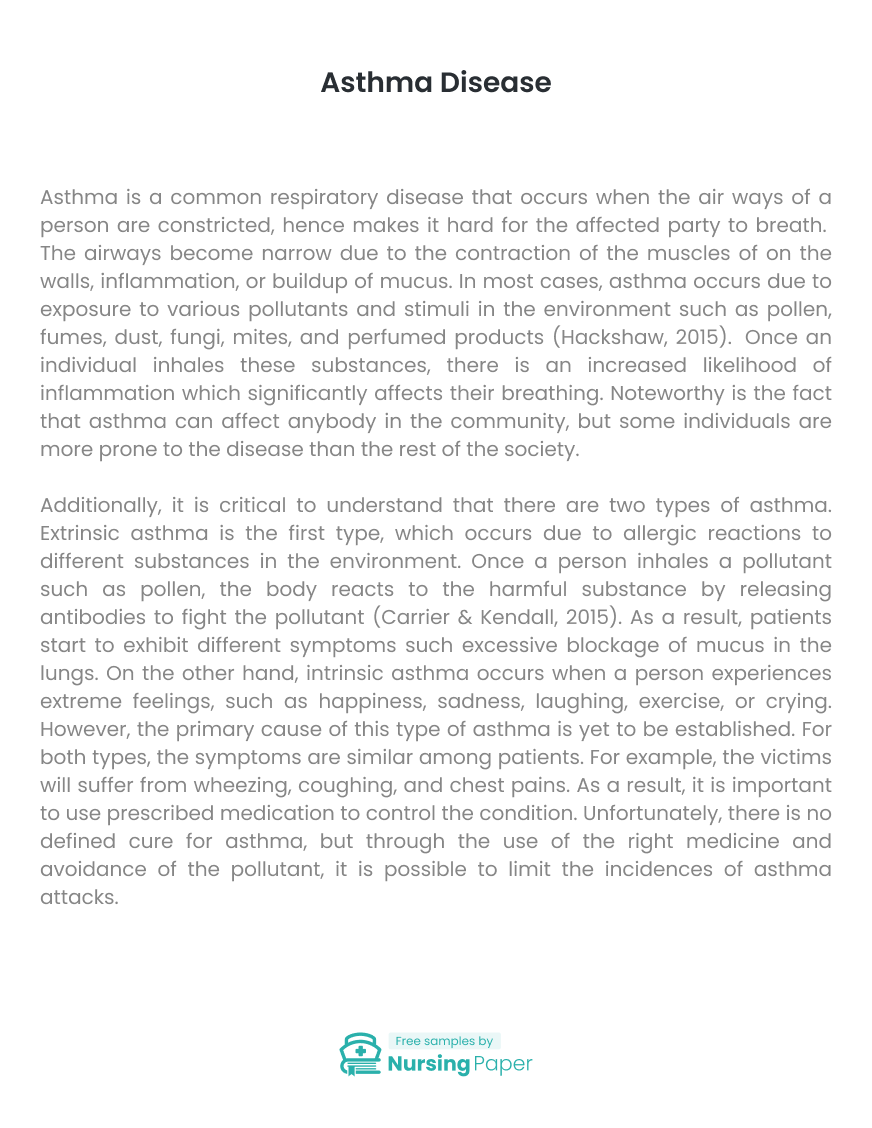
Introduction
Asthma is a common respiratory disease that occurs when the air ways of a person are constricted, hence makes it hard for the affected party to breath. The airways become narrow due to the contraction of the muscles of on the walls, inflammation, or buildup of mucus. In most cases, asthma occurs due to exposure to various pollutants and stimuli in the environment such as pollen, fumes, dust, fungi, mites, and perfumed products (Hackshaw, 2015). Once an individual inhales these substances, there is an increased likelihood of inflammation which significantly affects their breathing. Noteworthy is the fact that asthma can affect anybody in the community, but some individuals are more prone to the disease than the rest of the society.
Additionally, it is critical to understand that there are two types of asthma. Extrinsic asthma is the first type, which occurs due to allergic reactions to different substances in the environment. Once a person inhales a pollutant such as pollen, the body reacts to the harmful substance by releasing antibodies to fight the pollutant (Carrier & Kendall, 2015). As a result, patients start to exhibit different symptoms such excessive blockage of mucus in the lungs. On the other hand, intrinsic asthma occurs when a person experiences extreme feelings, such as happiness, sadness, laughing, exercise, or crying. However, the primary cause of this type of asthma is yet to be established. For both types, the symptoms are similar among patients. For example, the victims will suffer from wheezing, coughing, and chest pains. As a result, it is important to use prescribed medication to control the condition. Unfortunately, there is no defined cure for asthma, but through the use of the right medicine and avoidance of the pollutant, it is possible to limit the incidences of asthma attacks.


Currently, there is evidence of asthma epidemics. Since the disease is immeasurable, it is difficult to identify an epidemic in the population without undertaking detailed research among different groups of people in the society. Consequently, numerous researchers continue to analyze the occurrence and frequency of asthma on men, children, and women. This has led to the registration of a rise in the number of patients suffering from the disease; hence prove of an asthma epidemic in the world today. Moreover, there has been a discovery that young children are more likely to suffer from asthma, while women are also exhibiting rising numbers of asthma attacks.
Clearly, asthma is women’s major health issue. According to recent research on the condition, asthma among females is associated with menopause, menstrual period, and pregnancy among other conditions (Austin, Bentkover, & Chait, 2016). After childbirth, most women undergo a period of high stress, as they try to adjust their lives and routines around the new baby. Since they experience numerous and intense emotions during this time, they tend to develop intrinsic asthma. Moreover, as women continue to advance in age, they are more affected by this disease than men, hence the need to find a solution to the problem to limit the high prevalence rate of the condition among women.
1. Austin, J., Bentkover, J., & Chait, L. (2016). Leading strategic change in an era of healthcare transformation. Cham: Springer International Publishing.
2. Carrier, J., & Kendall, I. (2015). Health and the National Health Service (1st ed.). London: Routledge-Cavendish.
3. Hackshaw, A. K. (2015). A concise guide to observational studies in healthcare (2nd ed.). Chichester, West Sussex, UK: BMJ Publishing Group.



The download will start shortly.

The download will start shortly.
 Subject:
Medicine
Subject:
Medicine  Number of pages: 4
Number of pages: 4  Subject:
Health and Social Care
Subject:
Health and Social Care  Number of pages: 2
Number of pages: 2  Subject:
Nursing
Subject:
Nursing  Number of pages: 4
Number of pages: 4  Subject:
Medicine
Subject:
Medicine  Number of pages: 13
Number of pages: 13  Subject:
Medicine
Subject:
Medicine  Number of pages: 21
Number of pages: 21  Subject:
Medicine
Subject:
Medicine  Number of pages: 2
Number of pages: 2  Subject:
Medicine
Subject:
Medicine  Number of pages: 2
Number of pages: 2  Subject:
Medicine
Subject:
Medicine  Number of pages: 8
Number of pages: 8  Subject:
Nursing
Subject:
Nursing  Number of pages: 8
Number of pages: 8  Subject:
Health and Social Care
Subject:
Health and Social Care  Number of pages: 5
Number of pages: 5  Subject:
Medicine
Subject:
Medicine  Number of pages: 16
Number of pages: 16  Subject:
Medicine
Subject:
Medicine  Number of pages: 7
Number of pages: 7  Subject:
Medicine
Subject:
Medicine  Number of pages: 4
Number of pages: 4  Subject:
Health and Social Care
Subject:
Health and Social Care  Number of pages: 6
Number of pages: 6  Subject:
Medicine
Subject:
Medicine  Number of pages: 4
Number of pages: 4 
